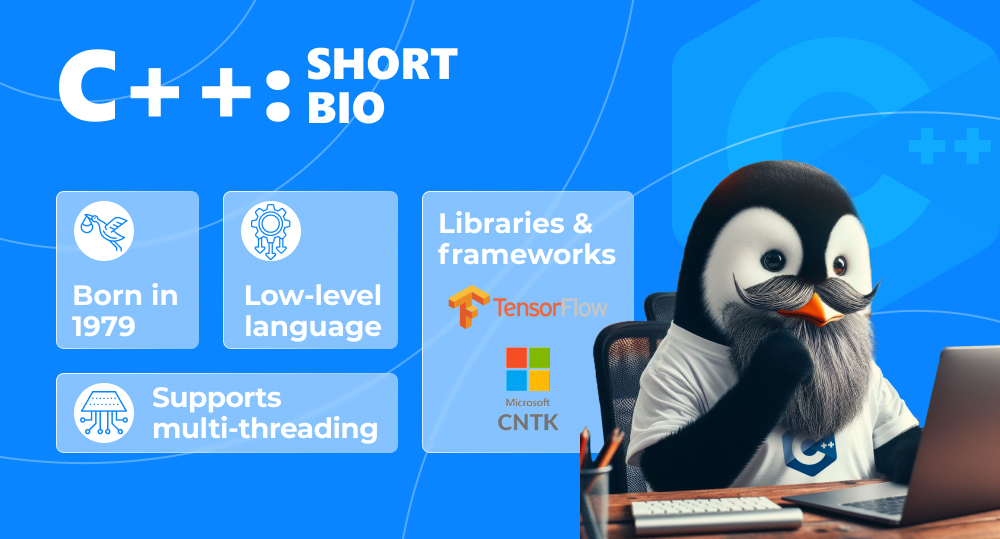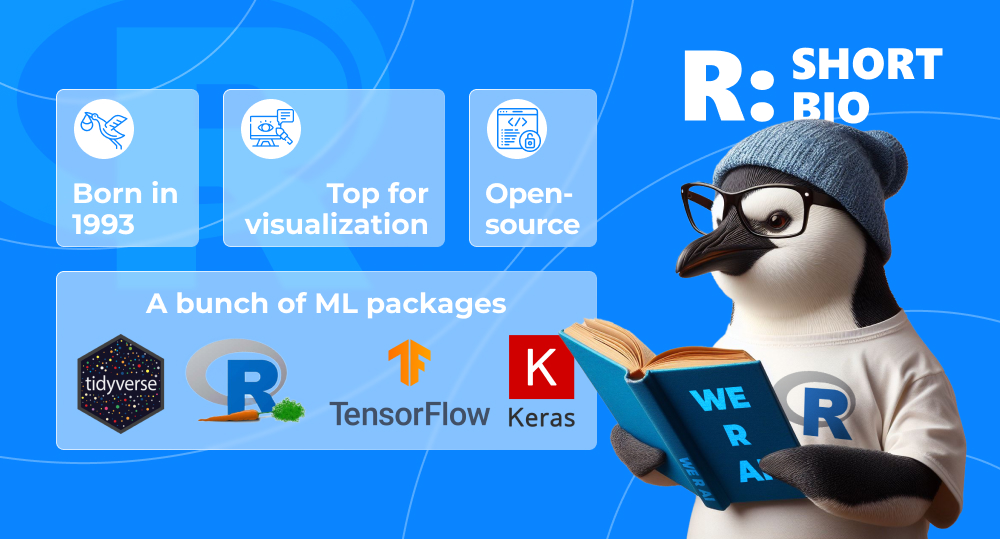You’re googling “What's the best language for AI development?” and see a dizzying array of options! Most likely, the first search result will be Python. But is it truly the best choice, or do newer, more robust contenders exist? Your colleagues might have mentioned the young and promising Julia, while competitors prefer good ol’ Java. What about the stats? Experts from Fortune have cast a wider net, suggesting SQL and C++ as viable alternatives. So which one is right for you?
To help you make a conscious choice, let's examine the technical strengths of each language and single out the one that aligns with your AI development goals for 2024.
written by:
Alexey Sliborsky
Solution Architect
You’re googling “What's the best language for AI development?” and see a dizzying array of options! Most likely, the first search result will be Python. But is it truly the best choice, or do newer, more robust contenders exist? Your colleagues might have mentioned the young and promising Julia, while competitors prefer good ol’ Java. What about the stats? Experts from Fortune have cast a wider net, suggesting SQL and C++ as viable alternatives. So which one is right for you?
To help you make a conscious choice, let's examine the technical strengths of each language and single out the one that aligns with your AI development goals for 2024.
Contents
Why Is AI Development a Big Thing in 2024?
While Elon Musk and other tech industry powerhouses hold conferences to regulate the use of artificial technology, global AI adoption is estimated to grow at 38.1% between 2022 and 2030 (Grand View Research). Even IoT technology, with its projected growth of 26.9% per year, is unlikely to catch up.
In 2024, the AI programming sector will take another leap forward, shaping the future of humanity even more. Why are we so sure? See for yourself!
Increased Availability of Data and Computing Power
With the advent of big data and computer science, AI algorithms gained access to vast amounts of information, enabling them to learn and make predictions with greater accuracy. This has opened up new opportunities in many areas:
- Healthcare;
- Finance;
- Medicine;
- Cybersecurity;
- Weather forecasting.
Potential to Revolutionize Our Lives
Thanks to advancements in machine learning, natural language processing, and computer vision, AI programming facilitates the automation of tasks that would normally require human intelligence (e.g., reasoning or problem-solving). From autonomous vehicles to virtual travel assistants and smart homes, AI is poised to change the way we live, study, work, and even sleep for the better.
Power to Tackle Challenges
Artificial intelligence is an incredible tool for addressing global issues like climate change and disease detection. By analyzing big data structures, AI can create trailblazing solutions for a brighter future for humanity.
In 2024, as AI continues to open new frontiers, we can expect further advances in material discovery, climate modeling, and especially disaster prediction models.
Soaring Demand for AI Talent
As more organizations accept the perks of artificial intelligence, the demand for skilled professionals capable of developing and deploying AI systems is on the rise. This has led to increased investment in AI education and training programs, along with the establishment of specialized research institutions.
5 Best Programming Languages for AI Development
AI is merging into our lives, it's profitable, and blah-blah-blah, you already know that. But what does it take to thrive in this industry? It's crucial to pick the most suitable (and the best) coding language for AI. What are your options?
Python: The Go-to Solution for AI Programming
Code Length
Typing
Difficulty
Performance
Libraries
Community
Released in 1991, Python has since evolved from a successor to the ABC language to the most popular programming language for AI. Originally created to simplify the lives of developers, it remains true to its cause. Even in complex areas like data science, machine learning, parallel and distributed computing, Python manages to stay user-friendly and concise. Is it the best code language for AI?
Why Love It:
- Readability and simplicity. Python's dynamic typing allows AI developers to quickly prototype and experiment with different ideas, building machine learning algorithms 2x faster.
- Vast collection of libraries and frameworks. Libraries such as TensorFlow, PyTorch, and Scikit-Learn contain many pre-built tools and algorithms for machine learning and training deep neural networks.
- Compatibility with other languages. Software engineering specialists can seamlessly integrate Python into any operating system and use it with other popular AI programming languages. Such flexibility makes this scripting language suitable for a wide range of artificial intelligence projects, from small experiments with modern web development to complex machine learning systems.
Why Hate It:
- Global Interpreter Lock (GIL) limitations. The GIL was introduced to keep Python memory management simple and prevent memory corruption. However, it has its downsides: limited parallelism and I/O-bound tasks. The good news: Python offers a toolkit to overcome these limitations, ranging from multiprocessing to asynchronous programming and external libraries. Just consider your app’s needs when choosing the right approach.
- Dynamism. Python’s dynamic type system is a double-edged sword for many. On the one hand, it grants flexibility by allowing variable type changes at runtime. No pre-declaration, just adapt them as needed. But beware of doubling cognitive load: developers must remember that types are dynamic. Without vigilance, it’s easy to accidentally assign the wrong types. When that happens, developers spend extra time debugging. This, in turn, translates to higher development costs and more coffee runs for the team.
Java: Power and Versatility for AI Projects
Code Length
Typing
Difficulty
Performance
Libraries
Community
Long
Static
Medium, requires more code than other languages
Relatively fast, especially with simpler tasks
Plenty
Large and active, 17.1M developers (Grid Dynamics, 2023)
Java, along with its buddy Python, has been sailing the waves of software development since 1991. Thirty years later, it's still widely used for artificial intelligence programming. Java fans praise its perfect combination of power and versatility with a dash of platform independence. Can it be the best programming language for AI for you, too?
Why Love It:
- Works with big data. Java's efficient memory management and mandatory garbage collection mechanisms make it an ideal choice for handling large volumes of data in AI applications.
- Extensive machine learning libraries. Weka, Encog, and other libraries come with built-in algorithms for such tasks as classification, regression, and clustering. This allows developers to focus on the high-level logic of their AI projects.
- Platform independence. We can call Java “a flexible language”, as its apps can run on multiple platforms that have a Java Virtual Machine (JVM). This flexibility is critical for any AI project requiring deployment in different environments or integration with existing systems.
- Community support. Java provides developers with a sheer wealth of helpful resources. Got questions about data analysis or artificial neural networks? You have a thriving Java ecosystem with millions of developers, rich with online forums, tutorials, and JUGs (Java user groups).
Why Hate It:
- Verbosity. Java is notorious for its verbose syntax, meaning it requires more lines of user code to accomplish certain tasks compared to other programming languages.
- Performance issues. Although Java is known for its speed and scalability, it isn't the best choice for compute-heavy tasks such as large datasets or complex AI algorithms, where other popular languages like C++ or Python perform better.
- Rigid nature. This general-purpose programming language doesn't allow much dynamism and experimentation, which are essential aspects of advanced development with AI and ML. For example, Java doesn't support multiple inheritance or operator overloading, limiting the expressiveness and creativity of Java programs.
- Java Virtual Machine. Why does this beating heart of the Java ecosystem fall victim to fierce debate? Low execution speed, cumbersome syntax, large memory usage, low-level access, single inheritance (one class — one superclass), and other most hated aspects of Java all come from one source — the JVM.
C++: Speed and Performance for AI Algorithms
Code Length
Typing
Difficulty
Performance
Libraries
Community
Long
Static
Difficult, requires a lot of manual actions
Fast and highly efficient
Plenty
Vast, 4.4M developers (Market Splash, 2023)
C++, a dear old geezer born in 1979, is still widely recognized as a good programming language for developing AI and machine learning algorithms. What does it have to offer, so we could call it the best computer language for AI?
Why Love It:
- Low-level language. C++ offers powerful features for low-level memory access, such as pointers and references. They allow developers to directly access and manipulate specific memory locations, providing greater control over intelligent algorithms.
- Parallelism. AI solutions often involve heavy computation and data processing. C++ supports multi-threading, enabling the distribution of tasks across different cores, which can significantly reduce the time required to process data.
- A rich set of AI and machine learning libraries. It provides out-of-the-box features that can be easily integrated into your projects. Popular solutions like TensorFlow and CNTK have C++ APIs, which offer extensive functionality and performance optimization.9
Why Hate It:
- Memory management. While this is a 100% perk for some, for others it's a never-again argument against C++. When dealing with memory allocation and deallocation, developers must exercise caution and manage memory properly to avoid data leaks or segmentation errors. Not to mention mandatory memory allocation and deallocation.
- Steep learning curve. C++ is a complex AI language that requires a deep understanding of programming concepts and syntax. It's statically typed, meaning that variables must be declared with specific data types before they can be used. While this helps catch errors at compile time, it can also slow down the development process.
R: The Language for Statistical Analysis in AI
Code Length
Typing
Difficulty
Performance
Libraries
Community
This one-letter word is a functional programming language that has gained immense popularity among data miners and statisticians. In the context of AI, R serves as an essential tool for data preprocessing, exploration, and visualization. What are the reasons to consider R the best programming language for AI development?
Why Love It?
- Visualization tools. With packages like ggplot2, users can generate high-quality graphics that effectively convey complex patterns and relationships within data.
- An open-source option. No license or fee is required to use, modify, and distribute this AI programming language.
- Powerful ML packages. These are libraries of pre-written functions for specific tasks: data analysis and manipulation, predictive modeling, and other areas relevant to AI.
Why Hate It?
- Too arcane. R may not be the most user-friendly option for developing complex AI architectures and algorithms, due to its unique (and sometimes mind-blowing) syntax and logic.
- Narrow focus. R is primarily designed for statistical analysis and data visualization, rather than complex AI algorithms. While it still has some capabilities for machine learning, many users find it not as robust and efficient as Python or Java.
Julia: The Emerging Language for Deep Learning
Code Length
Typing
Difficulty
Performance
Libraries
Community
What's your favorite female name? If you're an AI enthusiast, you may say “Julia” — it's widely considered the best language for AI and machine learning. Compared to other popular programming languages, this one is the youngest, created in 2012. Julia is a high-level programming language that was specifically designed for technical computing. It combines the ease and flexibility of dynamic languages like Python with the speed and efficiency of traditional compiled ones like C. What are the highlights of this newbie?
Why Love It:
- Intuitive syntax. It makes Julia way easier for researchers and practitioners to write and modify deep learning code without getting bogged down in complex equations.
- Dynamic nature. This characteristic allows for rapid prototyping and experimentation, enabling software engineers to seamlessly iterate and refine their models.
- Speed. With built-in support for distributed computing and parallelism, Julia empowers developers to train and deploy complex deep learning models with greater speed and efficiency.
Why Hate It:
- Immaturity. The community and ecosystem surrounding Julia may not be as extensive as those of Python or Java. Developers consider it more difficult to find support, libraries, and frameworks tailored to work with generative AI.
- Lack of documentation. While the language itself is well documented, there is a shortage of resources dedicated to AI development.
What’s the Best Programming Language for AI?
You've got five different programming languages to develop AI applications. And the world has a dozen more to offer you. How do you choose which one is the best programming language for AI and machine learning?
Python with its simplicity and extensive libraries? Java and its large ecosystem, platform independence, and scalability? Maybe C++ with its perks of low-level programming? Or R and Julia, less common but robust, highly specialized languages that excel in statistical analysis and data visualization?
With heaps of options available, it's truly overwhelming to make an informed decision on which one to use to create software (even for IT professionals, trust us!). However, there are two ways to make your life easier. You can either conduct your own research: read expert opinion and experiment with different technologies. Or you can turn to a competent team like Qulix for guidance and insights.
Still wondering which is the best programming language for your project? Contact us, and our experts will help you make up your mind and assemble the perfect team of seasoned AI developers.

Contacts
Feel free to get in touch with us! Use this contact form for an ASAP response.
Call us at +44 151 528 8015
E-mail us at request@qulix.com











